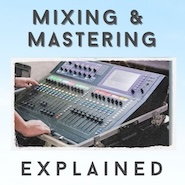What does Remastered Mean? What Needs to be Changed?

What does remastered mean? Remastering is a crucial process in the music industry that involves improving the quality of an audio recording.
It is done by taking the original recording and applying advanced techniques to enhance sound quality, such as equalization, compression, and noise reduction.
The result is a digitally remastered, higher fidelity version of the original mixes and recording with improved clarity, depth, and balance.
This process is particularly important for older analog recordings made before modern digital technology, as it allows them to be enjoyed with the same quality as modern recordings.
What Does Remastered Mean?
Remastering, technically known as digital remastering, involves enhancing the sound quality of a previously recorded track or album.
This process eliminates technical imperfections in the original recording, such as background noise.
It is also the process of taking an old master tape (analog tape) and making digital masters for archiving.
Remastering is a technique used to overcome the limitations of outdated recording methods. It involves refining various audio components, including the dynamic range of the music.
Sometimes, a record company will request a mastering engineer to make a specific master for vinyl records. The original music might be too bass-heavy and cause the needle on record players to jump out of the groove.
Game developers sometimes use remastered music on a sequel, taken directly from the original game. This makes old songs more compatible with a modern powerful console.
Music from older game tracks are also sometimes released as albums.
Why Are Old Songs Remastered?
Audio remastering is a common practice to fix errors and poor edits in original recordings of old songs.
The process involves enhancing the audio quality of the recording through various techniques, such as noise reduction, equalization, and dynamic range compression.
The remastered version is then released, often at a higher resolution, to improve the overall listening experience. This technique has been widely used in the music industry to revamp the works of iconic artists and bands, such as Led Zeppelin and The Beatles, to meet the evolving demands of modern listeners.
With this, you get to listen to your favorite albums in modern sound systems, with improved fidelity and sound quality.
Is A Remastered Version Better Than The Original?
Digital music remastering is a process that aims to enhance the quality of the original recordings.
The objective is to achieve a more refined and cleaner sound that conforms to current audio standards, while using the original source files or analog tapes.
This essentially makes older songs more compatible with new technology.
Digitally remastered records can reveal previously imperceptible nuances and voices buried in the original tracks. Effective noise reduction tools are crucial in eliminating unwanted sounds that can detract from the quality of the music.
However, it is essential to ensure that the remastering tools are appropriately applied to produce a superior original version, without compromising the original recording.
A notable example of the debate surrounding remasters is the album Death Magnetic by Metallica. It received criticism for its loud volume levels in the original release, leading to a demand for a remastered version.
Remastering is done on many different
How Is Remastering Done?
The remastering process involves hiring an audio engineer who uses specialized mastering and restoration tools to get the best sound out of a already mastered recording.
The engineer carefully listens to the original master tapes to detect any imperfections in the recording and employs various techniques to adjust the mix and remove unwanted sounds, such as clicks or whistles. Compression is also often applied during the mastering process to improve the recording's overall quality.
Sometimes, a digital audio workstation (DAW) is used to edit and record music and is preferred by many record companies and artists.
The ultimate goal of mastering engineers is to maintain the original feel and essence of the master recording while improving its overall quality.
What Is The Difference Between A Master And A Remaster?
Mastering music is a crucial phase of post-production in music, where the final touches are added to a track.
The process involves utilizing various techniques, such as equalization and compression, to ensure that the song's overall sound is impeccable.
Once the mastering process is complete, the track is ready for distribution across different platforms.
Remastering is a similar process; however, it takes place later than mastering. Whereas mastering is completed during post-production, remastering is done later.
The method of remastering involves re-performing the final mastering touches to an already mastered track to upgrade its sound quality.
The music production process revolves around the work of the remastering engineer.
What Is The Difference Between A Remake And A Remaster?
A remake will occur when an album is re-recorded, thus creating an entirely new master. Meanwhile, to remaster music, you just take the original mastering and update its sonic quality.
What Does Remastering An Album Mean?
Audio tracks are often subjected to remastering, either by individual tracks or as complete albums. Remastering music involves enhancing the audio quality by utilizing advanced technology. The objective is to provide fans with an improved listening experience that preserves the original artistic intent.
Final Thoughts
The process of song remastering offers a viable solution for bringing classic albums to today's audio standards.
By applying modern audio techniques, these songs can be transformed into a more polished and refined sound, allowing fans to enjoy an enhanced listening experience.
The remastered versions are typically available in a high-quality digital format, providing a refined listening experience from their original analog counterparts.
Contributors:
- Jerry Borillo - Illustrator












